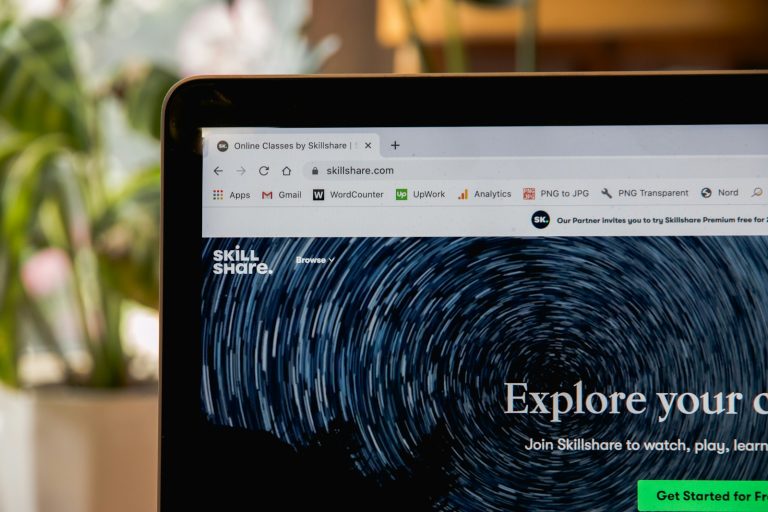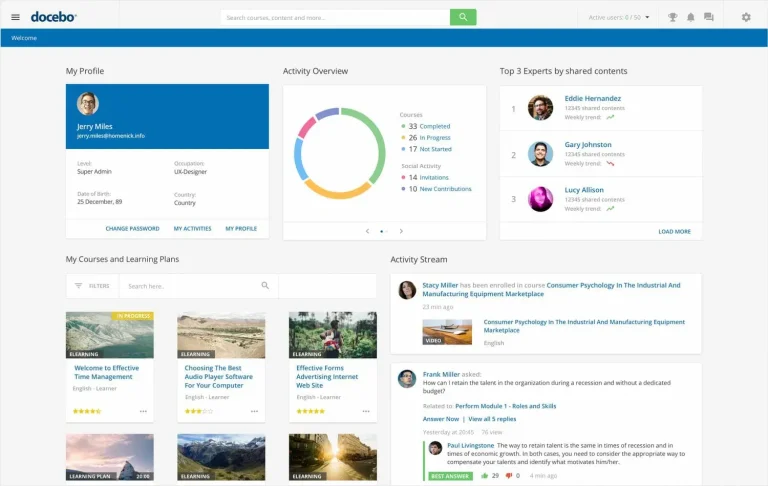6 Incredible Example of Micro Learning Formats for 2025
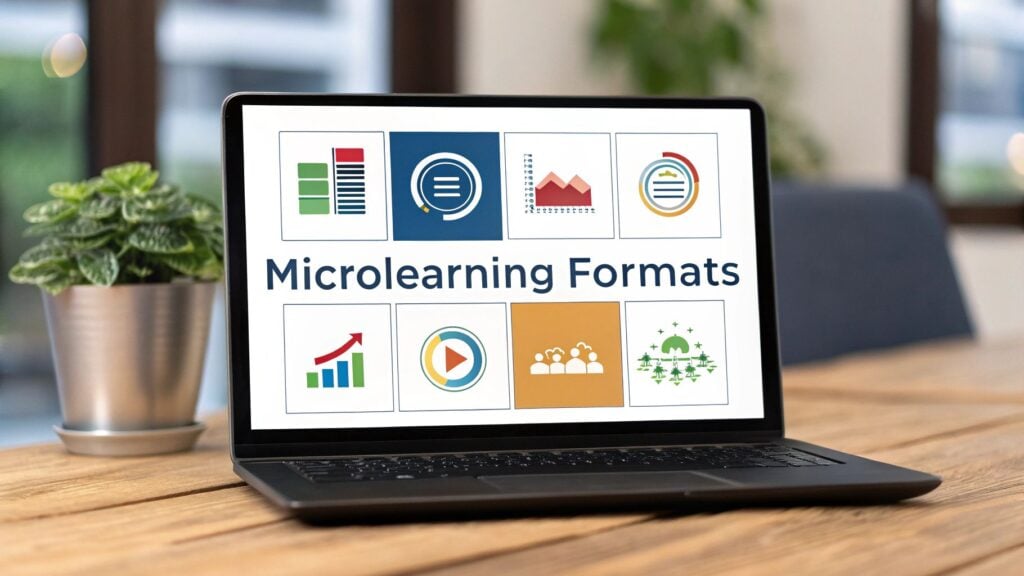
I get it, finding time for learning can feel impossible. We’re all juggling a million things, and the idea of sitting through a long training course just isn’t realistic anymore. The modern learner needs content that is quick, focused, and fits into their busy schedules.
That’s where microlearning comes in. It’s all about delivering quick, focused learning nuggets that you can digest in minutes, not hours. Think of it as learning on the go, designed for how we actually live and work today. Instead of overwhelming learners with dense information, this approach provides just what they need, right when they need it. To understand the foundational concepts and benefits, you can explore a helpful article detailing what micro training entails.
This guide is all about action. I’m going to walk you through six powerful examples of micro learning, from interactive quizzes to scenario-based simulations. We will also break down exactly why they work, the specific audiences they serve, and most importantly, how you can start implementing these ideas in your own projects right away.
Let’s dive in and see how small, targeted lessons can make a huge impact on skill development and knowledge retention.
1. Bite-Sized Video Tutorials
Short, focused video tutorials are probably the most recognizable example of micro learning in action. These are typically 2-5 minute videos made to teach a single, specific concept, skill, or task. Instead of a long lecture, learners get a concentrated dose of information that they can watch quickly, understand easily, and apply immediately.
Think about the last time you needed to learn how to use a specific function in a spreadsheet. You probably looked for a short, direct video, not a 45-minute webinar. That’s the power of this format.
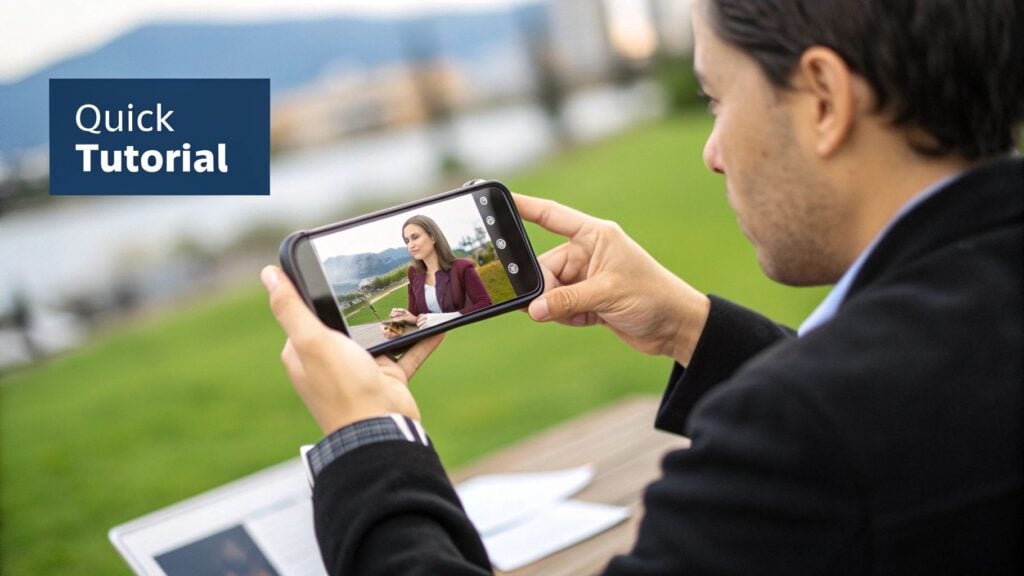
This approach is incredibly popular because it respects the learner’s time and provides just-in-time knowledge. Companies like HubSpot Academy and Microsoft use this format a lot to demonstrate software features. Platforms like Khan Academy and LinkedIn Learning have built entire educational libraries around these quick, digestible video lessons. The key is their laser focus on a single learning objective.
Strategic Breakdown
So, why does this format work so well? Let’s break it down.
- High Engagement: The short duration captures and holds attention, reducing the risk of learners dropping off.
- Targeted Problem-Solving: Learners can quickly find a video that solves their immediate problem without sifting through irrelevant content.
- Easy Retention: Focusing on one concept at a time improves knowledge retention and reduces cognitive load.
- Mobile-Friendly: These videos are perfect for on-the-go learning on any device, fitting easily into a busy schedule.
To maximize the impact and clarity of your bite-sized video tutorials, a crucial technique involves using effective strategies for engaging text overlays on video. This helps reinforce key points and makes the content more accessible.
Actionable Takeaways
Ready to create your own? Here are some practical tips to get you started:
- Define a Single Objective: Before you hit record, ask yourself: “What is the one thing I want my learner to know or do after watching this?” Stick to it.
- Script and Storyboard: Even for a 3-minute video, a simple script or storyboard makes sure you stay on topic and deliver information logically.
- Prioritize Audio Quality: Viewers will forgive mediocre video quality, but poor audio is a deal-breaker. Use a good microphone.
- Add Visual Cues: Use screen callouts, zooms, and text overlays to highlight important steps and keep the viewer focused.
- Create a Playlist: Group related micro-videos into a logical series or playlist. This creates a clear learning path for those who want to dive deeper.
For more in-depth guidance on the production side, you can explore more techniques on how to create compelling course videos.

2. Interactive Quizzes and Knowledge Checks
Interactive quizzes are a powerful example of micro learning that goes beyond just passively consuming content. These are short, engaging assessments made to test a specific piece of knowledge right after it’s learned.
Instead of a formal, high-stakes exam, think of these as quick, low-pressure checks that use formats like multiple-choice, drag-and-drop, or scenario-based questions. They reinforce key concepts through active participation and immediate feedback.
This method turns learning into a two-way street. Platforms like Duolingo have mastered this by embedding quick quizzes after every short lesson, making sure you actively recall vocabulary before moving on. Similarly, corporate training tools like those in SAP’s SuccessFactors use knowledge checks to confirm understanding of compliance or product information. The immediate feedback loop is crucial because it corrects misconceptions on the spot and builds learner confidence.
Strategic Breakdown
So, why are these quick checks so effective? Let’s get into the strategy.
- Active Recall: Quizzes force the brain to retrieve information rather than just recognize it, which is a proven method for strengthening long-term memory.
- Immediate Feedback: Learners instantly know if they are correct or incorrect. This allows them to self-correct and fill knowledge gaps in real-time.
- Boosts Engagement: The interactive and sometimes game-like nature of quizzes, popularized by apps like Kahoot!, makes learning more fun and less of a chore.
- Identifies Weaknesses: Both learners and instructors can quickly identify topics that need more review. This makes learning paths more efficient and personalized.
To truly capitalize on this format, you have to design questions that are both engaging and effective. You can get more ideas on how to make your online course quizzes interactive to ensure your learners are getting the most out of the experience.
Actionable Takeaways
Want to start using knowledge checks in your own training? Here are a few practical tips:
- Focus on One Idea: Each quiz should test a single learning objective or a very small, related group of concepts. Keep it short and to the point.
- Provide Explanatory Feedback: Don’t just say “Correct” or “Incorrect.” Briefly explain why an answer is right or wrong to reinforce the learning.
- Mix Up Question Types: Keep learners engaged by using a variety of formats. Alternate between true/false, multiple-choice, and simple scenario questions.
- Use Scenarios for Application: Instead of just asking for a definition, present a mini-scenario that requires the learner to apply their new knowledge.
- Keep the Stakes Low: Frame these as “knowledge checks,” not “tests.” The goal is to support learning and not to create anxiety or pressure.
3. Infographic Learning Cards
Infographic learning cards are a great example of micro learning that transforms complex information into a visually engaging, single-page format. These graphics blend text, images, icons, and charts to explain a concept, process, or set of facts in a way that is easy to digest in just a minute or two.
Instead of reading a dense article, learners can absorb key takeaways from a beautifully designed card. This makes it perfect for quick reference and knowledge reinforcement.
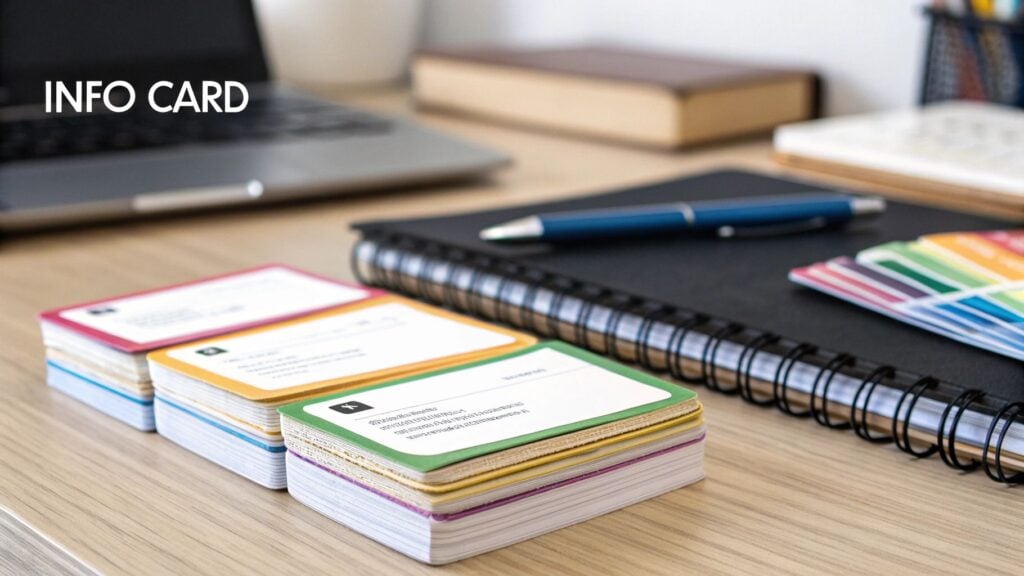
This format thrives on its shareability and visual appeal, which makes learning feel less like a chore and more like discovery. You can see this approach used effectively by companies like Canva, which provides templates for educational infographics, and organizations like the CDC, which uses them to communicate critical health information clearly. Buffer also uses this style for its social media tip cards, delivering valuable advice in a format that’s perfect for its audience.
Strategic Breakdown
So, why are these visual cards such an effective microlearning tool? Let’s break down the strategy.
- High Information Density: They pack a lot of information into a small space without overwhelming the learner, thanks to smart visual design.
- Boosts Knowledge Retention: The combination of text and visuals leverages the picture superiority effect, where people remember images better than words alone.
- Extremely Shareable: Their self-contained and visually appealing nature makes them ideal for sharing on social media, in newsletters, or via messaging apps.
- Serves as a Job Aid: These cards function as excellent performance support tools or “cheat sheets” that employees can save and refer back to when needed.
Actionable Takeaways
Want to create your own infographic learning cards? Here are some practical tips to get started:
- Focus on One Core Idea: Just like a micro-video, each infographic should have a single, clear learning objective. Don’t try to cover too much ground.
- Establish a Visual Hierarchy: Use size, color, and placement to guide the learner’s eye through the information in a logical sequence. The most important point should stand out.
- Use Data Visualization: When presenting statistics or data, use simple charts, graphs, or icons. This makes numbers much easier to understand and remember.
- Keep Text Minimal: Use short sentences, bullet points, and concise headings. Let the visuals do most of the heavy lifting.
- Optimize for Mobile: Design with a vertical, scrollable format in mind, as many learners will be viewing these on their phones. Ensure text is large enough to be read easily on a small screen.
4. Mobile Push Notifications with Learning Content
Push notifications are a powerful, often underestimated, example of micro learning. These brief, direct messages pop up on a learner’s mobile device, delivering tips, facts, quiz questions, or reminders.
This method pushes a tiny, relevant piece of learning directly to the user instead of waiting for them to pull information. This creates a continuous and almost effortless learning experience. Think of Duolingo’s daily reminders to practice a language or Headspace’s gentle nudges to take a mindful moment. That’s micro learning integrated into daily life.
This strategy excels at reinforcing knowledge and building habits. Apps like Blinkist send daily book insights, and Grammarly offers quick writing tips, keeping learning top-of-mind without being intrusive. The key is delivering just-in-time, contextually relevant information that adds immediate value. It transforms a mobile device from a distraction into a consistent learning companion.
Strategic Breakdown
So, why does this format work so well for continuous learning? Let’s break it down.
- Spaced Repetition: Notifications are perfect for delivering content at strategic intervals, which is proven to boost long-term memory retention.
- Just-in-Time Delivery: They can provide timely reminders or information right when the learner is most likely to need it or be receptive.
- Low Friction: Learners don’t have to actively seek out content. The learning comes directly to them, requiring minimal effort to engage.
- Habit Formation: Consistent, small nudges help build a regular learning routine, turning education into a daily habit rather than a chore.
To make these notifications even more effective, it’s vital to pair them with a well-designed mobile learning experience. You can find excellent insights into creating one by learning how to build an educational app.
Actionable Takeaways
Want to leverage push notifications in your learning strategy? Here are some practical tips:
- Define a Clear Purpose: Each notification should have a single, clear goal. Is it a reminder, a quiz question, a fun fact, or a call to action?
- Keep it Short and Sweet: Your message must be concise and instantly understandable. Think headlines, not paragraphs. Add an emoji or two to grab attention.
- Personalize and Time it Right: Use data to send notifications at optimal times for your audience. A personalized message that addresses the user’s progress is far more effective.
- Provide Immediate Value: The user should feel that opening the notification was worthwhile. Offer a useful tip, an interesting fact, or a quick challenge.
- Make it Easy to Opt-Out: Respect your users. Provide clear, simple instructions for managing notification preferences to avoid frustrating them.
5. Scenario-Based Simulations
Scenario-based simulations are a powerful example of micro learning that places learners directly into realistic, virtual workplace situations. These interactive exercises, often lasting just 5 to 10 minutes, challenge individuals to make critical decisions and solve problems.
The beauty of this format is its branching nature. The choices a learner makes lead to different outcomes, creating a dynamic and personalized learning path that demonstrates the real-world consequences of their actions.
This “learning by doing” approach is incredibly effective for developing complex skills like sales negotiation, patient diagnosis, or customer service conflict resolution. Learners apply a theory in a safe, controlled environment rather than just reading about it. Companies like IBM and many medical schools use these simulations to prepare their teams for high-stakes interactions, making sure they are ready before they face the real thing.
Strategic Breakdown
So, why are these short, interactive stories so effective for learning? Let’s look at the strategy behind them.
- Active Decision-Making: Learners are not passive recipients of information. They must actively analyze situations and make choices, which deeply embeds the learning.
- Safe-to-Fail Environment: Simulations provide a space to make mistakes and see the outcomes without real-world negative consequences. This fosters experimentation and confidence.
- Immediate Feedback: Every choice receives immediate feedback through the story’s progression, reinforcing correct actions and clarifying misconceptions in the moment.
- Contextual Relevance: By mirroring actual job challenges, the learning is immediately applicable and bridges the gap between training and on-the-job performance.
The following decision tree helps illustrate when this type of micro learning is the most strategic choice for a training need.
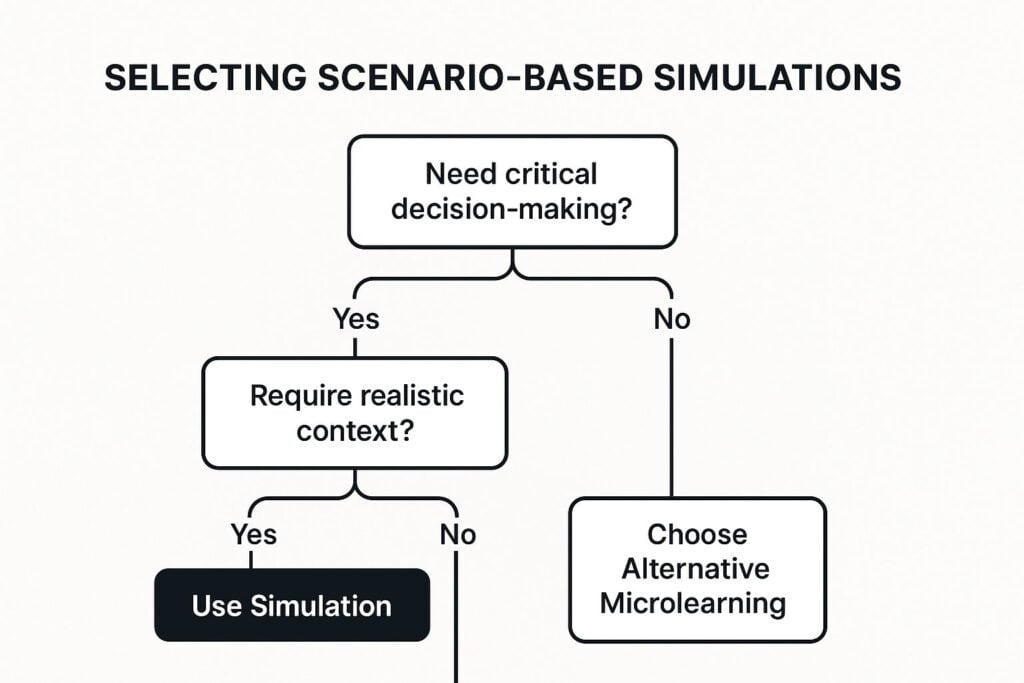
This visual guide confirms that simulations are ideal when your learning objectives require trainees to practice making critical decisions within a realistic context.
Actionable Takeaways
Want to build your own engaging simulations? Here are some practical tips to get started:
- Start with Real Problems: Base your scenarios on actual challenges your team faces. Interview top performers and ask, “What’s a common, tricky situation you have to navigate?”
- Map Out Branches: Use a simple flowchart to map the decision points and their consequences. Make sure to include both correct and common incorrect paths.
- Provide Consequence-Based Feedback: Instead of just saying “Correct” or “Incorrect,” show the outcome of the choice. For example, a poor choice in a sales simulation might result in the virtual client ending the meeting.
- Keep it Focused and Realistic: Each simulation should center on a single learning objective. Keep the decision points clear and avoid overly complex or unrealistic situations that could confuse the learner.
- Encourage Re-attempts: Allow learners to go back and try a different path. This reinforces the learning by letting them see how different choices lead to better outcomes.
To further boost engagement, you can incorporate game mechanics into your scenarios. You can explore a deeper dive into how to use gamification in eLearning to make your simulations even more compelling.
6. Flashcard-Style Spaced Repetition
Flashcard-style spaced repetition takes a scientifically proven learning technique and transforms it into a powerful example of micro learning. This method uses digital flashcards that present information at increasing intervals over time.
The system’s algorithm shows you concepts you struggle with more frequently, while pushing back the ones you’ve mastered. It’s a highly efficient way to move information from short-term to long-term memory. You engage in quick, daily review sessions that feel manageable yet produce significant results, instead of cramming.
This approach is rooted in the “forgetting curve” research by Hermann Ebbinghaus. His work showed that we forget things at a predictable rate unless we review them. Platforms like Anki, Quizlet, and Memrise have popularized this by turning the theory into a practical tool. They are widely used by medical students memorizing complex anatomy and language learners acquiring new vocabulary. This proves how effective this micro learning format is for retaining dense information.
Strategic Breakdown
So, why is this method so effective for long-term learning? Let’s break it down.
- Optimized for Retention: The algorithm is designed to combat the forgetting curve, presenting information right before you are about to forget it.
- Active Recall: It forces you to actively retrieve information from memory rather than passively reviewing it, which strengthens neural pathways. To see various applications of augmented reality in education that align with micro-learning principles, explore these 8 Augmented Reality Education Examples.
- Personalized Learning: The system adapts to your individual performance, focusing your effort where it is needed most and saving you time.
- Efficient and Fast: Daily review sessions are often short, typically lasting just 5 to 15 minutes. This makes it easy to build a consistent learning habit.
Actionable Takeaways
Want to leverage spaced repetition in your own learning or teaching? Here are some practical steps:
- Keep Cards Atomic: Each flashcard should focus on one single, discrete piece of information. Avoid cluttering cards with multiple concepts.
- Frame as Questions: Instead of just putting a term and its definition, phrase the front of the card as a question. This encourages active recall.
- Use Visual Aids: Incorporate images, diagrams, or even short audio clips on your cards to create stronger mental associations and make learning more engaging.
- Review Consistently: The system works best with regular, ideally daily, reviews. Consistency is more important than the length of each session.
- Be Honest with Your Self-Assessment: When the system asks how well you knew the answer, be honest. This data is what allows the algorithm to personalize your review schedule effectively.
Microlearning Methods Comparison Table
| Method | Implementation Complexity | Expected Outcomes | Ideal Use Cases | Key Advantages |
|---|---|---|---|---|
| Bite-Sized Video Tutorials | Low to moderate (video production skills needed) | Quick skill acquisition, visual understanding | Visual learners, technical/software training, procedural tasks | High engagement, mobile-friendly, cost-effective |
| Interactive Quizzes and Knowledge Checks | Moderate (question design, platform integration) | Immediate reinforcement, progress tracking | Knowledge retention, compliance, skill assessment | High interactivity, scalable, tracks gaps |
| Infographic Learning Cards | Low (graphic design skills required) | Quick concept understanding, easy sharing | Data presentation, process explanation, quick reference | Highly visual, memorable, shareable |
| Mobile Push Notifications with Learning Content | Moderate to high (requires app infrastructure) | Habit formation, repeated exposure | Habit building, behavioral change, just-in-time learning | High visibility, personalized, low time needed |
| Scenario-Based Simulations | High (complex development, SME input) | Critical thinking, practical skills, decision-making | Soft skills, compliance, sales, leadership, customer service | Engaging, realistic, assesses competency |
| Flashcard-Style Spaced Repetition | Moderate (algorithm and app integration) | Long-term retention, memorization | Language learning, medical education, exams | Scientifically proven, adaptive, self-paced |
Putting It All Together for Your Learners
I’ve walked you through a variety of powerful microlearning examples, from bite-sized video tutorials and interactive quizzes to immersive scenario simulations and simple flashcards. Each one shows a different way to deliver focused, relevant learning in the exact moment of need. The common thread is clear: effective learning is about delivering the right knowledge, in the right format, at the right time.
Looking at a strong example of micro learning, like a well-designed infographic or a timely push notification, reveals a core strategy. The goal is to make learning a natural part of your audience’s daily routine, not a disruptive event they have to schedule. By breaking down complex topics into digestible pieces, you lower the barrier to entry and make continuous development feel effortless.
Your Action Plan for Implementing Microlearning
So, what’s next? It’s time to move from inspiration to action. Don’t feel overwhelmed by all the options. Instead, think about how you can start small and build momentum.
Here are a few concrete steps you can take right now:
- Identify One Key Concept: Look at your existing course or training material. What is the single most important or most misunderstood concept? This is your perfect candidate for a microlearning pilot.
- Choose the Right Format: Based on that concept, select the best format. Is it a process that would benefit from a short video tutorial? Or is it a set of facts perfect for an infographic or flashcard deck? Match the format to the learning objective.
- Create Your First Asset: Dedicate a small amount of time to creating just one piece of content. Don’t aim for perfection. Aim for completion. The goal is to create a tangible example of micro learning you can test.
- Deploy and Gather Feedback: Share it with a small group of learners. Ask them specific questions. Was it helpful? Was it clear? Did it fit into their workflow? Use this feedback to refine your approach.
The Bigger Picture: Building a Learning Habit
Mastering these microlearning strategies is about more than just creating cool content. It is about fundamentally shifting how you approach education and training. You are moving from being a one-time content provider to becoming a continuous learning partner for your audience.
By providing consistent, valuable, and easy-to-consume learning moments, you help your audience build a genuine learning habit. This improves knowledge retention and skill application, and it also boosts engagement and loyalty. People will keep coming back because they know you provide real value without demanding hours of their time.
The power of thinking small is that it leads to big, sustainable results. Start today, pick one idea from this list, and see how a tiny piece of learning can make a huge impact. You have the tools and the examples, now go build something amazing for your learners.


